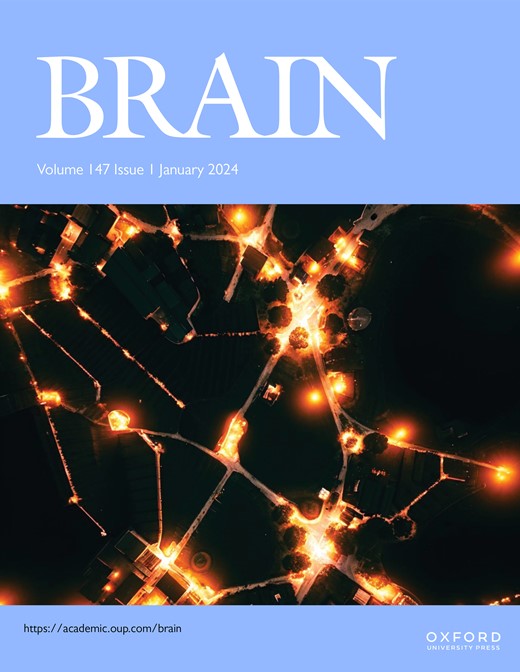Mitochondrial dynamics and bioenergetics in Alzheimer’s induced pluripotent stem cell-derived neurons
IF 10.6
1区 医学
Q1 CLINICAL NEUROLOGY
引用次数: 0
Abstract
Mitochondrial (MT) dysfunction is a hallmark of Alzheimer’s Disease (AD), but the scope and severity of these specific deficits across forms of AD are not well characterized. We designed a high-throughput, longitudinal, phenotypic assay to track MT dynamics and bioenergetics in glutamatergic iPSC-derived human neurons possessing mutations in presenilin 1 (PSEN1), presenilin 2 (PSEN2) and the amyloid beta precursor protein (APP). Each gene set was comprised of iPSC-derived neurons from an AD patient as well as two to three engineered mutations with appropriate isogenic and age matched controls. These iPSC-derived neurons were imaged every other day beginning at DIV10 to assess how MT length and content change over a ten day time course using a mitochondrially targeted reporter. A second cytosolic reporter allowed for visualization of neurites. Bioenergetics assays, focusing on MT respiration and individual electron transport chain (ETC) complexes, were also surveyed over this time course. Mutations in all three genes altered MT function measured by basal, ATP-linked, and maximal oxygen consumption rate; and spare respiratory capacity, with PSEN1/PSEN2 alleles being more severe than APP mutations. Electron flow through Complexes I-IV was decreased in PSEN1/PSEN2 mutations but; in contrast, APP alleles had only modest impairments of Complexes I and II. We measured aspects of MT dynamics, including fragmentation, and neurite degeneration, both of which were dramatic in PSEN1/PSEN2 alleles, but essentially absent in APP alleles. The marked differences in MT pathology may occur from the distinct ways amyloids are processed into amyloid beta peptides (Aβ) and may correlate with the disease severity.阿尔茨海默氏症诱导多能干细胞衍生神经元的线粒体动态和生物能
线粒体(MT)功能障碍是阿尔茨海默病(AD)的特征之一,但这些特定功能障碍在不同形式的阿尔茨海默病中的范围和严重程度还没有得到很好的描述。我们设计了一种高通量、纵向、表型检测方法,以跟踪谷氨酸能 iPSC 衍生的人类神经元中的 MT 动态和生物能,这些神经元中的 presenilin 1 (PSEN1)、presenilin 2 (PSEN2) 和淀粉样 beta 前体蛋白 (APP) 存在突变。每个基因组都由来自AD患者的iPSC衍生神经元以及两到三个具有适当同源和年龄匹配对照的工程突变组成。从 DIV10 开始,每隔一天对这些 iPSC 衍生神经元进行成像,以使用线粒体靶向报告器评估 MT 长度和含量在十天时间内的变化情况。第二种细胞质报告物可使神经元可视化。在此过程中,还进行了生物能测定,重点是 MT 呼吸和单个电子传递链 (ETC) 复合物。所有三个基因的突变都会改变MT的功能,具体表现为基础耗氧率、ATP连接耗氧率和最大耗氧率;以及剩余呼吸能力,其中PSEN1/PSEN2等位基因的突变比APP突变更为严重。PSEN1/PSEN2基因突变后,通过复合物I-IV的电子流减少,但相比之下,APP等位基因仅对复合物I和II造成轻微损伤。我们测量了MT动力学的各个方面,包括碎裂和神经元变性,这两种情况在PSEN1/PSEN2等位基因中都非常显著,但在APP等位基因中基本上不存在。淀粉样蛋白加工成淀粉样β肽(Aβ)的方式不同,可能导致MT病理学的明显差异,并可能与疾病的严重程度相关。
本文章由计算机程序翻译,如有差异,请以英文原文为准。
求助全文
约1分钟内获得全文
求助全文
来源期刊

Brain
医学-临床神经学
CiteScore
20.30
自引率
4.10%
发文量
458
审稿时长
3-6 weeks
期刊介绍:
Brain, a journal focused on clinical neurology and translational neuroscience, has been publishing landmark papers since 1878. The journal aims to expand its scope by including studies that shed light on disease mechanisms and conducting innovative clinical trials for brain disorders. With a wide range of topics covered, the Editorial Board represents the international readership and diverse coverage of the journal. Accepted articles are promptly posted online, typically within a few weeks of acceptance. As of 2022, Brain holds an impressive impact factor of 14.5, according to the Journal Citation Reports.
 求助内容:
求助内容: 应助结果提醒方式:
应助结果提醒方式:


